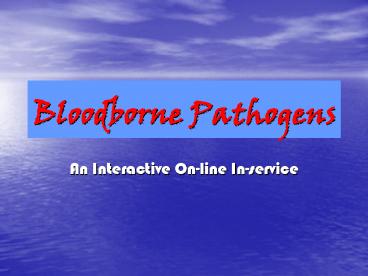Bloodborne Pathogens - PowerPoint PPT Presentation
1 / 15
Title:
Bloodborne Pathogens
Description:
Hepatitis symptoms. Initially flu-like. Fatigue. Loss of appetite. Mild fever. Vomiting ... No symptoms at all. Hepatitis B virus. Causes hepatitis. HIV. AIDS ... – PowerPoint PPT presentation
Number of Views:194
Avg rating:3.0/5.0
Title: Bloodborne Pathogens
1
Bloodborne Pathogens
- An Interactive On-line In-service
2
Annual Bloodborne Pathogens In-service
- In compliance with the Federal Regulations of the
Illinois Department of Labor and the Illinois
State Board of Education, annual training on
bloodborne pathogens is required for all
employees of Community Consolidated School
District 15. - Your participation in this interactive on-line
in-service will - fulfill your requirement
- assist the district with compliance
- and provide a safer work environment.
- Please read the following lesson.
- Then answer the questions to the BBP follow-up
quiz that can be found on the CCSD15 server.
3
Background of Law
- In 1993, the United States Department of Health
adopted the Occupational Safety and Health
Administration (OSHA) standards for bloodborne
pathogens.
- This law required employers having employees with
occupational exposure to bloodborne pathogens to
establish a written Exposure Control Plan. - The purpose of this plan is to eliminate or
minimize employee exposure.
4
Community Consolidated School Dst 15 Bloodborne
Pathogen Exposure Control Plan
- Identifies compliance methods and work practice
controls. - Identifies methods of decontamination and
disposal. - Identifies job classifications with occupational
exposure. - Is available at each school health office within
Community Consolidated School District 15 to
read, borrow or copy.
5
Occupational Exposure
- Employees who are occupationally exposed can
reasonably anticipate exposure to infectious
materials resulting from the performance of
his/her duties. - The Hepatitis B immunization is available through
the district to these identified employees.
6
Universal Precautions
- Is an approach to infection control.
- Is based on the concept that all human blood, and
certain body fluids must be treated as if known
to be infectious of HIV, HBV, and other
bloodborne pathogens. - Require special consideration within work
practices because of the potentiality of
exposure.
7
Two Common Bloodborne Pathogens
- HBV
- Hepatitis B virus
- HIV
- Human immunodeficiency virus
8
HBV
- Hepatitis B virus
- Causes hepatitis
- Hepatitis symptoms
- Initially flu-like
- Fatigue
- Loss of appetite
- Mild fever
- Vomiting
- Diarrhea
- Sore joints/muscles
- Later
- Yellow skin
- Yellow sclera (whites of eyes)
- Cirrhosis of the liver
- Carriers
- No symptoms at all.
- Hepatitis
- Infection (inflammation) of the liver
- Life-threatening
- No known cure
- Spontaneous recovery can occur
- Rest and healthy diet can speed the recovery
9
HIV
- Human immunodeficiency virus
- Causes AIDS (acquired immunodeficiency syndrome)
- AIDS symptoms
- Initially
- No symptoms at all
- Several years later
- Fever
- Diarrhea
- Fatigue
- Loss of appetite
- Weight loss
- End-stage
- Frequent infections
- Severe infections
- Cancer
- AIDS
- Attacks the bodys immune system
- Disables defense system
- Life-threatening
- No known cure
10
Breaking the chain of transmission of bloodborne
pathogens
- proper hand washing before and after touching
potentially infectious area - the use of a protective barrier gloves
- proper disposal of contaminants
- peeling off gloves inside-out keeping soiled area
inside - disposing of extensively soiled articles to
hazardous waste - proper clean up contain exposure and contact
custodian.
The importance of handwashing in the
prevention of disease cannot be
overstated !
11
Exposure incident
- contact between a bodily fluid of another and a
cut/abrasion or mouth, eyes, nose.
12
Exposure incidents
- Exposure incidents can occur in a workplace when
someone becomes sick or injured any scraped knee
or upset stomach. - The first impulse is to attend to the injured or
ill especially when children are involved. - To minimize exposure incidents, Community
Consolidated School District 15 provides all
employees with - access to hand washing
- personal protective equipment.
- Every exposure incident requires a post-exposure
follow-up. The staff in the school health office
can assist with the follow-up.
13
Personal Protective Equipment
- The personal protective equipment consists of
gloves and towels that are found in each staffs
first aid kit . - The first aid kits will be distributed to your
mailbox or can be located in the school health
office. - Supplies can be replenished in the school health
office.
14
YOUR RESPONSIBILITIES!!
- All employees are required to use Universal
Precautions when assisting students or staff who
are injured or ill. - Gloves must be readily accessible and used.
- Vigorous hand washing must be performed after
degloving.
Remember treat all bodily fluids as if known to
be infectious !
15
Follow-up Quiz
- Please print this page, then take the Bloodborne
Pathogens CCSD15 quiz at - http//quizstar.4teachers.org/index.jsp
- Choose Student Login Page (student site)
- Click on the arrow Sign Up
- Fill out the student registration information
- Then search for the class Bloodborne Pathogens
CCSD15 by instructor Susan Arndt - If you get interrupted and need to take the quiz
again, please contact Susan Arndt,
arndts_at_ccsd15.net, to reset your quiz - Questions? Contact Susan Arndt, 963-3151































